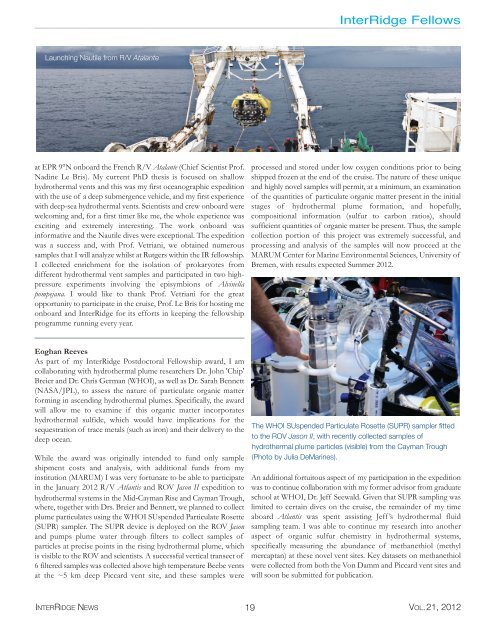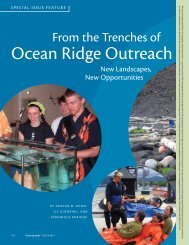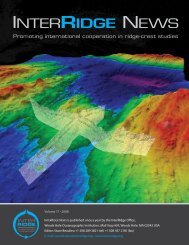Full version, low resolution, 7.5MB - InterRidge
Full version, low resolution, 7.5MB - InterRidge
Full version, low resolution, 7.5MB - InterRidge
You also want an ePaper? Increase the reach of your titles
YUMPU automatically turns print PDFs into web optimized ePapers that Google loves.
<strong>InterRidge</strong> Fel<strong>low</strong>s<br />
Launching Nautile from R/V Atalante<br />
at EPR 9°N onboard the French R/V Atalante (Chief Scientist Prof.<br />
Nadine Le Bris). My current PhD thesis is focused on shal<strong>low</strong><br />
hydrothermal vents and this was my first oceanographic expedition<br />
with the use of a deep submergence vehicle, and my first experience<br />
with deep-sea hydrothermal vents. Scientists and crew onboard were<br />
welcoming and, for a first timer like me, the whole experience was<br />
exciting and extremely interesting. The work onboard was<br />
informative and the Nautile dives were exceptional. The expedition<br />
was a success and, with Prof. Vetriani, we obtained numerous<br />
samples that I will analyze whilst at Rutgers within the IR fel<strong>low</strong>ship.<br />
I collected enrichment for the isolation of prokaryotes from<br />
different hydrothermal vent samples and participated in two highpressure<br />
experiments involving the episymbions of Alvinella<br />
pompejana. I would like to thank Prof. Vetriani for the great<br />
opportunity to participate in the cruise, Prof. Le Bris for hosting me<br />
onboard and <strong>InterRidge</strong> for its efforts in keeping the fel<strong>low</strong>ship<br />
programme running every year.<br />
processed and stored under <strong>low</strong> oxygen conditions prior to being<br />
shipped frozen at the end of the cruise. The nature of these unique<br />
and highly novel samples will permit, at a minimum, an examination<br />
of the quantities of particulate organic matter present in the initial<br />
stages of hydrothermal plume formation, and hopefully,<br />
compositional information (sulfur to carbon ratios), should<br />
sufficient quantities of organic matter be present. Thus, the sample<br />
collection portion of this project was extremely successful, and<br />
processing and analysis of the samples will now proceed at the<br />
MARUM Center for Marine Environmental Sciences, University of<br />
Bremen, with results expected Summer 2012.<br />
Eoghan Reeves<br />
As part of my <strong>InterRidge</strong> Postdoctoral Fel<strong>low</strong>ship award, I am<br />
collaborating with hydrothermal plume researchers Dr. John 'Chip'<br />
Breier and Dr. Chris German (WHOI), as well as Dr. Sarah Bennett<br />
(NASA/JPL), to assess the nature of particulate organic matter<br />
forming in ascending hydrothermal plumes. Specifically, the award<br />
will al<strong>low</strong> me to examine if this organic matter incorporates<br />
hydrothermal sulfide, which would have implications for the<br />
sequestration of trace metals (such as iron) and their delivery to the<br />
deep ocean.<br />
While the award was originally intended to fund only sample<br />
shipment costs and analysis, with additional funds from my<br />
institution (MARUM) I was very fortunate to be able to participate<br />
in the January 2012 R/V Atlantis and ROV Jason II expedition to<br />
hydrothermal systems in the Mid-Cayman Rise and Cayman Trough,<br />
where, together with Drs. Breier and Bennett, we planned to collect<br />
plume particulates using the WHOI SUspended Particulate Rosette<br />
(SUPR) sampler. The SUPR device is deployed on the ROV Jason<br />
and pumps plume water through filters to collect samples of<br />
particles at precise points in the rising hydrothermal plume, which<br />
is visible to the ROV and scientists. A successful vertical transect of<br />
6 filtered samples was collected above high temperature Beebe vents<br />
at the ~5 km deep Piccard vent site, and these samples were<br />
The WHOI SUspended Particulate Rosette (SUPR) sampler fitted<br />
to the ROV Jason II, with recently collected samples of<br />
hydrothermal plume particles (visible) from the Cayman Trough<br />
(Photo by Julia DeMarines).<br />
An additional fortuitous aspect of my participation in the expedition<br />
was to continue collaboration with my former advisor from graduate<br />
school at WHOI, Dr. Jeff Seewald. Given that SUPR sampling was<br />
limited to certain dives on the cruise, the remainder of my time<br />
aboard Atlantis was spent assisting Jeff ’s hydrothermal fluid<br />
sampling team. I was able to continue my research into another<br />
aspect of organic sulfur chemistry in hydrothermal systems,<br />
specifically measuring the abundance of methanethiol (methyl<br />
mercaptan) at these novel vent sites. Key datasets on methanethiol<br />
were collected from both the Von Damm and Piccard vent sites and<br />
will soon be submitted for publication.<br />
INTERRIDGE NEWS 19 VOL.21, 2012
















